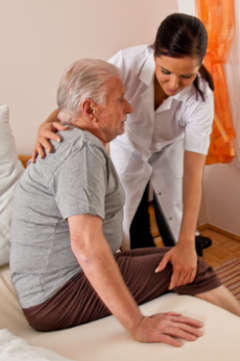 As we age, it can become a challenge to keep up with self-care. Many seniors move into skilled nursing facilities when they have lost the ability to independently perform activities commonly known as “activities of daily living” (ADLs). This term was first coined in the 1950s by American physician Sidney Katz.
As we age, it can become a challenge to keep up with self-care. Many seniors move into skilled nursing facilities when they have lost the ability to independently perform activities commonly known as “activities of daily living” (ADLs). This term was first coined in the 1950s by American physician Sidney Katz.
What are these common skills and how are they used to evaluate senior health?
Index of Independence in Activities of Daily Living
Dr. Katz and his team at the Benjamin Rose Hospital outlined six basic physical needs that all humans have. It is expected we are able to independently perform the following actions:
- Bathing: Bathe or shower completely independently, with the exception of help with one area (i.e. hair washing).
- Dressing: Select clothes and dress, including buttons and other fasteners.
- Toileting: Sit and stand up from the toilet, as well as independently clean oneself.
- Transferring: Walk from one place to the next, including getting up from bed and moving.
- Continence: Control one’s bladder and bowels.
- Feeding: Chew and swallow safely, feed oneself using utensils.
For healthcare professionals and the families of aging individuals, these basic activities can indicate whether or not a person can function without help from someone else. As older people begin to lose the ability to perform these ADLs, a mental or physical condition could be developing.
Using ADLs For Senior Evaluation
While the average person may take ADLs for granted, the inability to perform them can lead to a diminished quality of life and increased likelihood of premature death. Understanding the basic ADLs is essential for caregivers, who often spend the most time with aging individuals. Caregivers should be looking for lapses in self-care that could indicate a more serious issue. For instance, someone who loses the mental capacity to match clothing for an outfit may be experiencing early signs of dementia – a condition that affects 1 in 6 people over age 80. If sudden changes occur, the caregiver may consider the following:
- Is he/she completely incapable of performing the task? Katz uses a scale of 0 to 6, with 0 being absolutely unable without help.
- Could there be another factor affecting his/her ability to perform an ADL? For example, fatigue or sickness.
- Who else spends time with the individual? Have they noticed any gradual or sudden changes?
Caregivers can use the Katz Index of Independence in Activities of Daily Living to assess and determine if the senior’s score warrants movement to a skilled nursing facility.
Avon Health Center has an experienced medical and nursing staff who can help your loved one experience a better quality of life in a safe environment. To learn more about our admissions process, contact us today!
« Driving Safety Tips for Seniors

